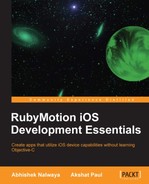Let's recap what we have done in this chapter:
- Created a simple RubyMotion application
- Discussed the basic RubyMotion application structure
- Explored the commands available with RubyMotion
- Performed different Rake tasks with RubyMotion
- Learned how to configure your RubyMotion application
- Worked with the interactive console—REPL
- Debugged your application using the RubyMotion debugger
In the next chapter, we turn our attention to RubyMotion data type objects—such as strings and arrays. We will also learn how to interface with C and we will focus on memory management in RubyMotion.
..................Content has been hidden....................
You can't read the all page of ebook, please click here login for view all page.
